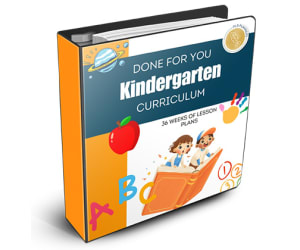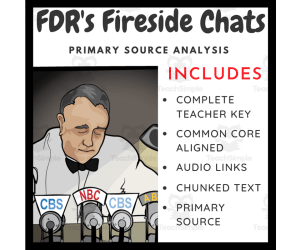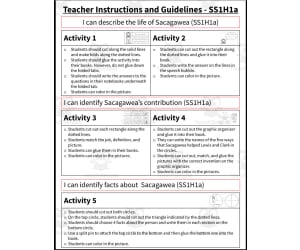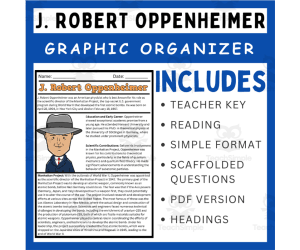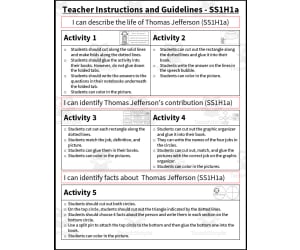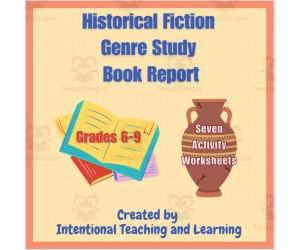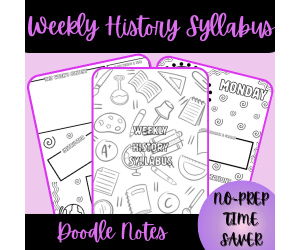2,738 products added recently
Social Studies Graphic Organizers
Support your social studies curriculum with graphic organizers designed to help students process historical events, cultural practices, and societal structures. These resources facilitate critical thinking and make connections clearer. Use them to enrich discussions and deepen comprehension in your social studies classes.
Coloring Pages - Flags of Europe
Geography, Social Studies, Elementary, High School, Middle School, Graphic Organizers, Teacher Tools, Drawing Templates & Outlines, Worksheets & Printables, Worksheets
With more than 750 million inhabitants, Europe is the third most populated continent in the world while being the second smallest, after Australia. It is largely located in the Eastern Hemisphere and all of it is in the Northern Hemisphere. Africa and Asia share the continent of Europe, which is referred to as Afro-Eurasia. Approximately 10.53 million square kilometers (4.06 million square miles) make up the continent of Europe. The Atlantic Ocean borders Europe to the west, and the Arctic Ocean borders Europe to the north. The Mediterranean Sea lies to the south, while the Black Sea, Caspian Sea, and Ural Mountains form its eastern borders. This ebook includes 50 coloring pages with the flags of all countries of Europe. Each coloring page features the name of the country, the original flag in full color, and the flag in black and white line drawing ready to be colored. The countries are presented in alphabetical order.
Author Bright Classroom Ideas Marketplace
Tags Coloring Pages, Flag, Europe
Kindergarten Full Curriculum PowerPoint Bundle | 36 Weeks of Editable
ELA, Math, Science, Social Studies, Special Resources, P.E. & Health, Kindergarten, Lesson Plans, Teacher Tools, Graphic Organizers, Literacy Readers
Make your planning easy with this complete Kindergarten Curriculum PowerPoint Bundle. This bundle gives you 36 weeks of ready-to-use lessons for the full school year. It includes 1,202 editable slides across four PowerPoint files. You can open the files, teach the lessons, and adjust anything to fit your class. It saves time and supports consistent, engaging instruction. Language and literacy, math, science, social studies, arts, physical education, and social and emotional development are all covered each week. Lessons help young students develop strong early skills and adhere to specific learning objectives. A presentation guide, a diploma for students, and an end-of-year capstone project with straightforward instructions are all included in the bundle. Use these slides for digital instruction, centers, morning meetings, small groups, and whole-class instruction. Pages for practical exercises can also be printed. Both homeschooling and classroom settings benefit greatly from this resource. Teachers adore this curriculum's comprehensiveness, adaptability, and structure. This full-year customizable bundle will give your kindergarten curriculum structure and originality. Get it and begin instructing right now.
Author Bright Classroom Ideas Marketplace
Rating
Tags Kindergarten, Curriculum, Lesson, Plan, Math, Ela, Science, Social, Project, Worksheet
FDR's Fireside Chats: Primary Source Analysis & Graphic Organizer
Social Studies, History, History: USA, Grade 8, 9, 10, 11, Teacher Tools, Graphic Organizers
Get ready to explore the captivating world of Franklin D. Roosevelt's Fireside Chats with our comprehensive Primary Source Analysis and Graphic Organizer resource, perfect for high school American History and Government classes. This well-rounded educational package is designed to help your students dive deep into the historical significance of President FDR's ground-breaking radio addresses. Our all-inclusive bundle is packed full of engaging materials that bring FDR's Fireside Chats to life in your classroom. Students will be encouraged to participate in stimulating activities such as examining a detailed background of the chats, analyzing carefully selected primary source excerpts, and pulling out key evidence from FDR’s speeches using an easy-to-follow graphic organizer . Witness your students' critical thinking skills flourish as they dissect first-hand accounts from two significant Fireside Chats – On Banking Crisis (1933) and On Farmers and Laborers (1936). They'll immerse themselves fully into these speeches while learning how to pinpoint their purpose & impact on public morale during volatile times in American history. This turnkey product has everything you need! You'll receive a digital teacher key alongside a student version, all available in printer-friendly PDF format. Don't miss this amazing opportunity to create memorable learning experiences for your students while connecting them with an unforgettable chapter of US Presidential history! Thumbnail Clipart Credit: Massare Clips and Design
Author EduPal Learning
Tags FDR, Roosevelt, Great Depression, Franklin D. Roosevelt, Fireside Chat, Primary Source , Analysis
Black History Month Juneteenth Biography Reading Graphic Organizer 4-5
Common Core, ELA, Social Studies, Reading, Reading Comprehension, Biographies, Grade 4, 5, 6, Activities, Crafts, Graphic Organizers, Teacher Tools
Introduce learners to the amazing lives of Black History Month and Juneteenth pioneers and personalities through this Black History Month | Juneteenth Pioneers Study Pack. Meticulously made for Graders 4, 5, 6, EFL/ESL students and homeschoolers, this jam-packed resource set includes: 2 SETS of 12 Pioneer Biographies Reading Comprehension (COLORED AND BLACK&WHITE SETS) Featuring: 1. Langston Hughes 2. Thurgood Marshall 3. Sojourner Truth 4. Martin Luther King Jr. 5. Sarah E. Goode 6. Wilma Rudolph 7. Billie Holiday 8. Bessie Coleman 9. George W. Carver 10. Phyllis Wheatley 11. Booker T. Washington 12. Ruby Bridges Foldable Biography Graphic Organizers for each pioneers Pioneers Cryptogram Quotes The biography reading comprehension set presents our special pioneers’ story that the students can explore and study. Through the reading texts, they can then complete the foldable graphic organizers that are perfect assessment project and even a perfect showpiece for open house programs! Finally, the cryptogram quote exercises are fun, yet purposeful, activities that the students can do as part of their reading exercise and a perfect addition to morning works. This Black History Month / Juneteenth Study Pack is perfect for ELA, social studies, reading comprehension, and reading project– a valuable resource in your teacher toolbox!
Author It's Teacher L
Tags Black History Month, Juneteenth, Black History Month Biographies, Reading Comprehension, Graphic Organizers, Biography Graphic Organizers, Cryptograms
French Revolution: Complete Graphic Organizer
Social Studies, History, History: Europe, History: World, Grade 8, 9, 10, 11, Teacher Tools, Graphic Organizers
The French Revolution was a period of radical social and political upheaval in France from 1789 to 1799. It began with the storming of the Bastille prison in Paris on July 14, 1789, and ended with the rise of Napoleon Bonaparte as Emperor in 1799. The French Revolution was sparked by a combination of economic, social, and political factors. France was facing a financial crisis due to its involvement in the American Revolution and the extravagant spending of King Louis XVI and his queen, Marie Antoinette. Meanwhile, the majority of the French population, particularly the lower classes, were suffering from poverty, starvation, and inequality. The revolution began with the Estates-General, a meeting of representatives from the three social classes in France, which had not been convened since 1614. The Third Estate, which represented the common people, demanded more representation and greater political power. When the king refused, the Third Estate declared itself the National Assembly and began drafting a new constitution. The revolution quickly turned violent, as crowds of angry Parisians stormed the Bastille and other symbols of the monarchy. In August 1789, the National Assembly abolished feudalism and established the Declaration of the Rights of Man and of the Citizen, which asserted the equality of all citizens before the law and guaranteed individual rights such as freedom of speech, press, and religion. The revolution continued with the Reign of Terror, a period of mass executions and political repression led by radical Jacobin leader Maximilien Robespierre. The Reign of Terror was brought to an end with the execution of Robespierre in 1794. In 1795, a new constitution was established, creating a Directory government. However, the Directory was plagued by corruption and instability, leading to the rise of Napoleon Bonaparte, who seized power in a coup d'état in 1799. The French Revolution had a profound impact on world history, inspiring political and social revolutions in Europe and beyond. Its legacy includes the spread of revolutionary ideals such as liberty, equality, and fraternity, the emergence of nationalism, and the transformation of Europe's political and social order. Teacher-prepared notes show students what is important and how ideas relate, and offer a model for how students should take notes themselves (Marzano et al., 2001). This graphic organizer helps students understand the underlining causes and effects of the French Revolution. The notes go over The Tennis Court Oath, the Bastille, and The Great Fear. These notes also cover the start and end of the Reign of Terror, and conclude with an overview of the rise and fall of Napoleon. Ready to print and ready to use! Clipart credit: By PrincePadania and byDandy Doodles
Author EduPal Learning
Tags French Revolution, Graphic Organizer, High Yield Strategy, Complete The Graphic Organizer
Bering Land Bridge - Graphic Organizer & Mapping Activity
Social Studies, History, History: USA, History: World, Grade 6, 7, 8, 9, Teacher Tools, Graphic Organizers
The Bering Land Bridge - Graphic Organizer & Mapping Activity This is a robust teaching resource crafted for grades 6 through 9 USA History and World History classes. It uniquely blends key concepts with strategies for note-taking, fostering an environment ripe for educational growth. Main Features: Specially made to help students grasp the major events surrounding the crossing of the Bering Land Bridge by hunter-gatherers. Features student-centric and instructor-focused notes, encouraging active content engagement while supporting teachers during instruction. Acts as a bridge between theory and practice, complementing classroom readings with additional ideas to stimulate insightful discussions. The built-in reading activity about the Bering Land Bridge, is an interactive exercise allowing students to understand about human migration patterns globally easily. The package also includes a mapping activity along with probing questions to further enhance comprehension levels across all learning stages. No extra purchases required; everything needed is included in this product bundle! The Power of Visual Aids: To promote knowledge retention effectively, this instructional resource incorporates relevant illustrations from Teachers Resource Force & Prince Padania. All these resources offer flexibility for adaptation - be they whole class activities, small group assignments or individual homework projects. In conclusion, any educator aiming to instill their students with thorough understanding of this global historical event will find 'The Bering Land Bridge - Graphic Organizer & Mapping Activity ' incredibly useful!
Author EduPal Learning
Tags Bering Land Bridge, Hunter-gatherers, Migration Patterns, Geographical Implications, Mapping Activity
Class Economy: Grade 4-7 Math, Financial Literacy and SS
Life Studies, Social Studies, Business, Finance, Home Economics, Math, Addition and Subtraction, Addition, Money, Subtraction, Economics, Grade 4, 5, 6, 7, Teacher Tools, Graphic Organizers
Do you want to teach your middle grades students in grades 4-7 about simple economics? Do you want help around the classroom with chores such as tidying up and putting away chairs? Then implement this class economy routine and teach your students about basic financial literacy, banking, and economics! Teacher Instructions: Set-Up: • This classroom economy is completely editable: leave it as it is or change it for your specific needs! • Review the jobs on page 3 and change them as necessary. Then print one copy of that page to sign up your students for one term (12 weeks), or you can type the names straight into the chart each week. • Review page 4. Add your class name at the top. Change the rewards to suit your class. Then print a double-sided page 4 & 5 for each of your students to keep in their binders. This is also enough for one term (12 weeks). Each week: • On the first Friday, give your students the handout and assign 2-3 students to each job. Explain what they must do to successfully complete their job next week. For example, the floor inspectors must check the floor before lunch and at the end of each day and clean up any paper or garbage. • Show your students the sample bank balance on page 6. Walk through how to complete the math and find the two missing balances ($20 and $30) together. • Discuss what fines and bonuses you might use. For example, students might earn $5 for being a great friend to someone who needs it, and they might incur a $5 fine for speaking out of turn repeatedly. • Each week, take 20 minutes on Friday to assign the jobs for next week. Students fill out their bank account balance and get it checked by the teacher. •Students can use their excess money to shop for rewards (and they may combine money together to get a large reward like a class movie). Inflation: • If you want to teach your students an extra lesson, incorporate some inflation into your economy. • After 8-10 weeks, let your students know that the desk rental price is increasing to $35. • Add $5 to each job salary. • Talk about how this will decrease their purchasing power, much like rising prices and stagnating salaries do in the real world. What's Included: 6 Pages in and EDITABLE Powerpoint - Step-by-step teacher instructions for this simple class routine: once started, it should take only 20 minutes every week! - Digital or printable weekly sign-up sheet with 8 class jobs - Student handout with instructions and 8 reward options - Student bank balance worksheet - Sample bank balance sheet: show your class and practice adding up deposits and withdrawals Grades to Use With: This classroom economy is specifically designed for students in the middle grades (4-7).
Author Grace Under Pressure
Tags Class Economy, Classroom Economy, Budget, Financial Literacy, Integers, Money, Class Rewards, Class Jobs, Bank Account, Class Routine
Progressive Era Muckrakers Reading & Graphic Organizer
Social Studies, History, History: USA, Grade 6, 7, 8, 9, 10, 11, 12, Teacher Tools, Graphic Organizers
This is a set of readings on the leading "muckrakers" of the Progressive Era. This resource includes a corresponding graphic organizer . I suggest to finish the lesson with an excerpt from Upton Sinclair’s The Jungle—a big hit with the high school set.
Author Exa's Excellent Social Studies Lessons
Tags Progressive Era, Muckrakers, The Jungle, Ida Tarbell, Theodore Roosevelt, Progressive Era Muckrakers Answer Key, Progressive Era Muckrakers Worksheet Answers, Modern Day Muckrakers
Cold War Overview: Graphic Organizer
Social Studies, History, History: Europe, History: World, Grade 7, 8, 9, 10, 11, Teacher Tools, Graphic Organizers
The Cold War was a time of tension and rivalry between the United States and the Soviet Union that lasted from the end of World War II in 1945 until 1991. The two superpowers never fought a direct war against each other, but they were involved in many proxy wars, such as the Korean War and the Vietnam War. The Cold War started because the United States and the Soviet Union had different ideas about how countries should be run. The United States believed in democracy, where the people elect their leaders and have individual freedoms. The Soviet Union believed in communism, where the government controls everything and everyone is equal. The United States and the Soviet Union both wanted to spread their ideas and influence around the world, which led to a lot of tension between them. They also built up huge military forces, including nuclear weapons, to try to scare each other into backing down. The most dangerous time during the Cold War was in 1962, during the Cuban Missile Crisis. The Soviet Union had secretly put nuclear missiles in Cuba, which is very close to the United States. The United States demanded that the missiles be removed, and there was a tense standoff between the two superpowers. Eventually, the Soviet Union agreed to remove the missiles, and the crisis was over. The Cold War ended in 1991 when the Soviet Union collapsed. The United States emerged as the world's only superpower, and there was a lot of hope for peace and cooperation between countries. While there are still tensions between countries today, the world is much more peaceful than it was during the Cold War. Teacher-prepared notes show students what is important and how ideas relate, and offer a model for how students should take notes themselves (Marzano et al., 2001). These teacher-created notes will help your students grasp the major events of the Cold War era. These notes work well as a supplement to class readings! Thumbnail and product clipart credit: By PrincePadania and byDandy Doodles This product provides students with an easy-to-understand overview of the major issues, leaders, and events associated with the Cold War.
Author EduPal Learning
Tags Cold War, Stalin, Graphic Organizer, High Yield Strategy
Sacagawea Interactive Notebook | SS1H1a, SS1H1b, SS1G1a, SS1CG1
Social Studies, Biographies, Preschool, Grade 1, 2, Teacher Tools, Graphic Organizers
Sacagawea Interactive Notebook covers biographical details and contributions of the Shoshone guide and interpreter who assisted the historic Lewis and Clark expedition. This printable 17-page packet allows students to journey alongside Sacagawea while learning social studies standards SS1H1a, SS1H1b, SS1G1a, and SS1CG1. Young learners will enjoy engaging cross-curricular activities like timelines, maps, flip books, diagrams , and graphic organizers. Teachers can utilize these materials during their early American history units for individual assignments or collaborative group projects. With complete teacher prep included, this interactive Sacagawea notebook easily integrates into lesson plans for kindergarten, first grade, and second grade classrooms seeking an inquiry-based approach connecting past to present.
Author Sarah Miller Tech
Tags Graphic Organizers, Sacagawea, Interactive Notebook, Comparing, Biographies
Truman and the Dropping of the Atomic Bomb: Graphic Organizer
Social Studies, History, History: USA, Grade 8, 9, 10, 11, Teacher Tools, Graphic Organizers
Harry S. Truman, the 33rd President of the United States, played a pivotal role in the development and use of atomic bombs during World War II. Truman assumed the presidency on April 12, 1945, following the death of President Franklin D. Roosevelt. At that time, the Manhattan Project , a secret research program focused on developing atomic weapons, was already underway. As President, Truman was faced with a difficult decision regarding the use of atomic bombs against Japan. The Manhattan Project had successfully created two atomic bombs, and Truman had to decide whether to deploy them as a means to end the war. After the war, Truman focused on preventing the spread of nuclear weapons. He supported the creation of the United Nations and played a key role in establishing the Baruch Plan, which proposed international control of atomic energy to prevent further proliferation. Truman's decision to use atomic bombs on Hiroshima and Nagasaki remains one of the most consequential actions of his presidency. It ushered in the nuclear age, shaped the course of history, and sparked ongoing discussions about the use and ethics of atomic weapons. Teacher-prepared notes show students what is important and how ideas relate, and offer a model for how students should take notes themselves (Marzano et al., 2001). This graphic organizer gives students two primary source quotes regarding Truman's use of the bomb. The notes then explain some pro/con arguments about the use of the bomb. Lastly, the notes give students a chance to look at the six immediate effects of the bomb. Comes with a fill-in-the-blank version. Clipart Credit: By PrincePadania
Author EduPal Learning
Tags World War II, Truman, Atomic Bomb, Manhattan Project, Japan, Cold War, Graphic Organizer, Pro Con Graphic Organizer
J. Robert Oppenheimer: Graphic Organizer
Social Studies, History, History: USA, History: World, Grade 6, 7, 8, Teacher Tools, Graphic Organizers
This J. Robert Oppenheimer: Graphic Organizer resource is focused on J. Robert Oppenheimer, a pivotal figure in 20th-century science and the development of the atomic bomb. Julius Robert Oppenheimer was not only an exceptional physicist but also a key player in shaping the course of history during World War II through his involvement with the Manhattan Project. Born in New York City in 1904, Oppenheimer's early years were marked by outstanding academic achievements. He pursued studies at esteemed institutions such as Harvard University and later secured his Ph.D. in theoretical physics from the University of Göttingen, Germany. His contributions spanned various facets of quantum mechanics and quantum field theory. However, his paramount influence emerged during the turbulent years of World War II. In 1942, Oppenheimer assumed the role of scientific director for the Manhattan Project, an initiative that bore heavy consequences with the bombings of Hiroshima and Nagasaki. His expertise and leadership were invaluable to the project's culmination. Post-war, Oppenheimer's journey continued in both academic circles and governmental sectors. He chaired the General Advisory Committee of the United States Atomic Energy Commission, advocating for judicious control over atomic energy. Regrettably, the McCarthy-era cast shadows over his accomplishments, leading to the revocation of his security clearance in 1954, a decision that was later revised, albeit not entirely overturned. Oppenheimer's passing in 1967 left behind a legacy characterized by brilliance, innovation, and moments of controversy. To aid in bringing this influential figure's narrative to our students, I've prepared a comprehensive overview of Oppenheimer's life, both preceding and following the Manhattan Project. This resource is complemented by 10 reading comprehension questions, alongside a detailed teacher key, ensuring a holistic teaching experience. It's formatted to be effortlessly integrated into our curriculum. Product Clipart: Prince Padania
Author EduPal Learning
Tags J. Robert Oppenheimer, Graphic Organizer, Manhattan Project, Oppenheimer, World War II, Atomic Bombs
Thomas Jefferson Interactive Notebook | SS1H1a, SS1H1b, SS1G1a, SS1CG1
Social Studies, Biographies, Preschool, Grade 1, 2, Teacher Tools, Graphic Organizers
Thomas Jefferson Interactive Notebook Bring Thomas Jefferson and early American history to life for students with this engaging social studies resource. This interactive notebook invites kids to immerse themselves in Jefferson's world through 17 skill-building activities. Learners will create timelines, map Jefferson's travels, analyze famous speeches and documents he authored, and more. The notebook covers key first grade social studies topics like basic economics and American symbols and holidays. Use it to teach standards SS1H1a, SS1H1b, SS1G1a, and SS1CG1. This printable packet allows students to actively process new information on Jefferson. Pair these materials with a biography and primary sources on America's third president. Differentiate instruction by using the notebook for whole-class learning, small groups, or independent practice. Get creative - the possibilities are endless!
Author Sarah Miller Tech
Tags Social Studies, Thomas Jefferson, Graphic Organizers, Venn Diagram, Presidents
Reconstruction 1865-1877 - Two Graphic Organizers
Social Studies, History, History: USA, Grade 8, 9, 10, 11, Teacher Tools, Graphic Organizers
Reconstruction 1865-1877 - Two Graphic Organizers This teaching resource delves into the critical period in American history that followed the Civil War. A valuable tool for educators of Grades 8 through 11, it provides comprehensive content on a complex epoch concerning History or Social Studies related to USA. Main Focus: The resource focuses majorly on Reconstruction protocols post-Civil War and outlines political, social, and economic shifts during this tenure. The primary objective was re-establishing Southern states which had seceded from the Union and integrating African Americans into society. Legislation Elements: 13th to 15th Amendments: Abolished slavery while providing citizenship rights to African Americans. Freedmen's Bureau Policy: Safeguarded interests of those recently freed from enslavement. Dual Graphics Organizers Feature: Packed with valuable information integrating politics within Postwar Reconstruction in South alongside a map highlighting Southern military districts—understanding how Southern states were readmitted post-war handling of issues regarding African American integration and determining controlling parties over Reconstruction. Challenges Faced: Resistance from opposing white Southerners. A rise in clans promoting racial segregation due to societal strains. Fraudulent methods used by white democrats regaining control leading up to Jim Crow era commencing racial segregation till Civil Rights Movement took charge later in mid-20th century. In addition, teacher-prepared notes help streamline complex narratives for students while boosting their note-taking skills (Marzano et al., 2001). Flexibility in Teaching Approach: With multiple file types, including teacher versions and student fill-in-the-blank ones paired with illustrative clipart (credit: Prince Padania), this resource provides flexibility for educators – suitable for large group discussions, small clusters, or homework assignments.
Author EduPal Learning
Tags Reconstruction, Civil War Aftermath, African American Integration, Legislative Changes, Social Challenges
Historical Fiction Genre Study Book Report
Social Studies, ELA, Reading, Reading Comprehension, Literature, Research, Grade 6, 7, 8, 9, Worksheets & Printables, Novel Studies, Teacher Tools, Graphic Organizers, Activities, Projects, Lesson Plans, Assessments, Worksheets
The 34-page Historical Fiction Genre Study Book Report is designed for grades 6th, 7th, 8th, and 9th, but it can easily be modified for lower or higher grades. This book report is an excellent supplement to a unit on a particular historical period. Through reading historical fiction, students can gain a deeper appreciation for historical periods and how they relate to the present day. The goal of this lesson is to introduce students to the genre of historical fiction and to help them understand its importance and significance. By the end of the lesson, students should have a good understanding of what historical fiction is. Students will read a historical fiction novel, analyze its characters, plot, and author's craft , and present their findings to a small group. The book report includes a detailed lesson plan on the historical fiction genre, objectives and learning targets aligned to the Common Core standards, directions for the book report with handouts and worksheets for students, a student self-evaluation, and a grading sheet for teachers. Many students enjoy reading historical fiction, especially if they are learning about the period in their History/Social Studies class. If you do the genre study component of this resource, the book report offers a high-quality culminating project. In addition, if you teach a Language Arts/History Core or plan with a History/Social Studies partner-teacher, this is an excellent resource for both classes and provides students with a different way to engage with history. Historical fiction is an essential genre for students for a variety of reasons because it makes the study of history more engaging and interesting and it brings the past to life. Students gain a deeper appreciation for historical periods and how they relate to the present day, It also improves critical thinking skills by giving students opportunities tothink critically about the events and people from the past, analyze and interpret historical events, understand different perspectives,and it encourages empathy, tolerance, and respect because students learn to see history through the eyes of characters from different time periods and cultures Historical Fiction Genre Study Book Report includes the following: 2 comprehensive and interactive lesson plans: Book Browse lesson plan Historical Fiction Genre lesson plan with common core standards, objectives, and learning targets easy-to-follow student directions Note taking Guide Note taking Guide Chart Spoke Diagram Plot Diagram Character Chart Sensory Description Chart Other Elements in Historical Fiction Chart Storyboard Presentation in Small Groups Directions Self-Evaluation of Historical Fiction Book Report Check-Off and Grading Sheet Other Resources You Might Be Interested In: Book Reports: Autobiography/Biography Genre Study Book Report and Speech Book into Movie Project: Compare and Contrast Book Report and Essay Book Jacket Book Report Character Analysis Essay, Gift for a Character Book Report, and Oral Presentation Historical Fiction Genre Study Book Report Historical Fiction Genre Study Literature Circle Project Poetry Book Report Mini-Reviews Book Report Mystery, Thriller, Horror, and Suspense Genre Study Book Report Narrative Nonfiction Genre Study Book Report Project Poetry Book Report Dystopian. Science Fiction, and Fantasy Genre Study Game Board Project Reading Units: Creating Independent Readers in your Middle School Classroom which is available as 1 unit or as individual resources Part 1: What We Do When We Read: Part 2: Reading Logs, Setting Goals, and Reflection Part 3: Summary Writing for Short Stories Part 4: Metacognitive Logs: Reading Response Bonus: How to Set Up An Amazing Classroom Library (without Spending Much Money): Google Slide Shows: Characterization: What It Is and How to Develop It Writing with Suspense If you have any questions, please email me at gruenwaldy1@gmail.com
Author Intentional Teaching and Learning
Tags Historical Fiction, Book Report, Research, Assessment, Story Elements, Analysis, History, Author's Craft, Critical Thinking, Self-evaluation
Weekly History Syllabus Doodle Notes
Creative Arts, Graphic Arts, ELA, Writing, Resources for Teachers, History, Social Studies, High School, Homeschool Resources, Middle School, Worksheets & Printables, Writing Prompts, Teacher Tools, Graphic Organizers, Outlines, Templates
Ever feel like your history lessons need a serious pick-me-up? After watching my teenager's eyes glaze over during one too many timeline activities, I knew I had to create something different! These Weekly History Syllabus Doodle Notes were born late one night at my kitchen table, surrounded by scattered history books and half-finished lesson plans that weren't working for either of us. As a fellow homeschool mom who's navigated the treacherous waters of teaching history to a teenager (who'd rather be doing ANYTHING else), I have poured all my real-world experience into these templates. Gone are the days of dry, boring history planning that puts both of us to sleep! Instead, I have created visual planning sheets that finally clicked for my visually-oriented teen. Now we're mapping out historical connections, documenting primary source readings, and planning research activities in a way that actually sticks! The magic happens when those historical concepts come alive through both organized planning AND creative visual elements. My daughter went from "Do we have to do history today?" to pointing out connections between historical periods on her own—I amnot kidding! These templates have completely transformed how history works in our homeschool, and I cannot wait for them to do the same for yours. INCLUDED IN THIS RESOURCE: Comprehensive weekly history planning template with visually engaging design Designated spaces for historical learning objectives, content focus, and instructor information Daily sections for documenting classwork, discussions, quizzes, and attendance Specialized reading assignment sections for historical texts and primary sources Homework planning areas with website research recommendations and writing prompts Visual note-taking spaces that connect historical concepts with creative representation Structured organization that accommodates the unique narrative nature of history instruction Look, I am not going to pretend I'm some super-organized homeschool mom with color-coded bookshelves (my laundry pile would quickly disprove that myth!). But after years of history lessons that felt like pulling teeth, these doodle notes have honestly saved our homeschool history curriculum. Sunday afternoons used to find me stressed and overwhelmed, staring at history books and wondering how to make centuries-old events relevant to my tech-obsessed teen. Now? I actually look forward to mapping out our history week! The combination of chronological organization with visual creativity means concepts stick in a way they never did before. My daughter has gone from glazed-over eyes to making connections between historical periods on her own. No joke—last week she compared political patterns from ancient Rome to something in today's news WITHOUT PROMPTING! Grab these templates today, and in a few weeks, you will be texting your homeschool friends about how your kid suddenly loves history. (And they'll demand to know your secret!) If you and your students/homeschoolers enjoyed this resources, please leave a review. Thank you for your support! Tina - Big Easy Homeschooling Mom Please subscribe: tidewindacademyhomeschool.com
Author Homeschool with Big Easy Homeschooling Mom
Rating
Tags History Doodle Notes, Visual Aids, Visual Learning Tools, Social Studies Planning, History Syllabus Templates, Doodle Notes, Homeschool History Organization, Homeschool Social Studies Organization Tools, Weekly History Planning Templates For Homeschoolers, Educational Organization
The Antebellum South: Graphic Organizer
Social Studies, History, History: USA, Grade 7, 8, 9, 10, Teacher Tools, Graphic Organizers
The Antebellum South: Graphic Organizer The Antebellum South: Graphic Organizer is a vital teaching resource designed to aid educators in imparting students with an intuitive understanding of the complex societal, economic, and cultural facets of the pre-Civil War era in the Southern United States. This tool proves particularly beneficial for Grade 7 to Grade 10 educators dealing with social studies. Key Features: Insightful Understanding: Alongside explaining topics like slavery and socio-economic division prevalent in the antebellum south, this resource also provides insights into cotton and tobacco - cash crops extensively farmed on plantation farms using enslaved Africans. All-encompassing narrative: This graphic organizer weaves together crucial events such as Nat Turner's rebellion while tracing debates sparked by southern leaders justifying slavery based on economic compulsions which simultaneously raised discussions around racial hierarchy and states' rights.(Refer to appended teacher notes) Versatility: Suitable for whole-class discussions, group activities or assigned as individual research work due to its self-explanatory design. Tailored Resources: Presented in PDF format, The Antebellum South: Graphic Organizer includes both a teacher-prepared notes variant complete with comprehensive explanations and a student variant that promotes self-learning. Note:The uniqueness lies in this tool's succinct yet informative approach – allowing grades 7-10 students to effectively grasp historical contexts without compromising on factual integrity solely aimed at enhancing their educational pursuits. As an added bonus, thumbnail clipart supplied by Clip Art Emporium makes it visually engaging. Not requiring additional software or resources adds icing on the cake – just print it out and you're all set! Encoded with rich education values, this ready-to-use tool indisputably becomes a wonderful addition to any classroom.
Author EduPal Learning
Tags Antebellum South, Graphic Organizer, Social Studies, Slavery, Plantation Farms
The Korean War 1950-1953: Graphic Organizer
Social Studies, History, History: Asian, History: USA, History: World, Grade 7, 8, 9, 10, 11, Teacher Tools, Graphic Organizers
The Korean War 1950-1953: Graphic Organizer This top-tier, educationally charged resource goes beyond just delivering the what and when of events. Rather it provides students a vivid understanding of how history unfolded. Specifically tailored for Grade 7 to Grade 11 social studies instruction. Carefully crafted four-paged overview outlining key events and influential figures from the Korean War era. Fills in an essential component in Asian, USA and World History subtopics. Developed with insights from Marzano et al.'s research compounded educational methodology background, . This ensures an effective mapping of relationships between various historical events instances thereby fostering comprehensive understanding among learners. Doubles as a demonstration of effective note-taking strategy for visual learners thanks to its meticulous design approach. Incorporates illustrative drawings from Illustration Station, adding visual interest and aiding content comprehension. This flexible teaching toolkit can be used across a variety of classroom scenarios: small group tasks, individual assignments or even as homework material. An included answer key ensures the educator is ever ready for spontaneous discussions within sessions. And all this comes in an editable PDF format that can smoothly become part of your digital or print classroom resources! The Korean War 1950-1953: Graphic Organizer - Your reliable companion facilitating every social studies lesson to transform into enlightening journey through time!.
Author EduPal Learning
Tags Korean War, Cold War, Asian History, USA History, World History, Korean War Clipart
Ronald Reagan and the Conservative Tide of the 1980s - Graphic Organizer
Social Studies, Economics, History, History: USA, Grade 8, 9, 10, 11, Teacher Tools, Graphic Organizers
"The conservative tide" is a term used to describe the increase in conservative political and social ideologies and policies that have been seen in many countries in recent years. The conservative tide can be seen as a reaction to the liberal or progressive movements that have made gains in areas such as civil rights, social justice, and environmental protection. The conservative tide has been evident in many countries, including the United States, the United Kingdom, and Australia. Some examples of the conservative policies that have been implemented include tax cuts for the wealthy, reductions in public services, and a push towards more traditional values and social norms. The conservative tide has been fueled by various factors, such as economic insecurity, cultural anxiety, and a desire for a return to what some see as "traditional" values. Conservative politicians have been successful in mobilizing support by tapping into these concerns and promising to address them through policies that emphasize personal responsibility and free market solutions. However, the conservative tide has also been met with resistance from those who see it as a threat to progress and social justice. The tension between these opposing forces has become a defining feature of modern politics, with debates over issues such as immigration, climate change, and social inequality often at the center of the discourse. Teacher-prepared notes show students what is important and how ideas relate, and offer a model for how students should take notes themselves (Marzano et al., 2001). These notes begin by looking at the four major goals of the conservative movement during the 1980s. Then, this graphic organizer looks at the causes and effects of the conservative tide that occurred during the 1980s. Comes with a student fill-in-the-blanks sheet. Ready to use! Thumbnail clipart credit: By PrincePadania
Author EduPal Learning
Tags Ronald Reagan, Conservatism , Conservative, Moral Majority, Graphic Organizer, APUSH, US History
AP Human Geography Folk vs. Pop Culture Graphic Organizer (e-fillable)
Social Studies, Geography, Grade 8, 9, 10, 11, Teacher Tools, Graphic Organizers
This graphic organizer was designed specifically for AP Human Geography students. This resource facilitates a detailed comparison between folk culture and popular culture, allowing students to take structured notes and to then save this document to study before the official AP exam. It could also be used in any middle school or high school geography class studying the topics of folk culture, popular culture, globalization, or cultural diffusion. Alternatively, this document could be used as guided-reading notes for any human geography textbook chapter that covers the topic of culture. Students will compare and contrast the origin, distribution, characteristics, and patterns of diffusion of folk culture and popular culture. The graphic organizer is available as an electronically fillable PDF, making it convenient for digital use. Alternatively, it can be printed out to accommodate tactile learners who prefer to take hand-written notes. It is a one-page pdf that can be downloaded and shared with students.
Author e-Learning with Erin
Tags AP Human Geography, E-fillable PDF, High School Geography, Study Tool, Graphic Organizer, Folk Culture, Pop Culture, Exam Prep, Note Taking
Shays' Rebellion: Cause and Effect Graphic Organizer
Social Studies, History, History: USA, Grade 7, 8, 9, 10, Teacher Tools, Graphic Organizers
Shays' Rebellion was primarily caused by a combination of economic and political factors that created discontent and frustration among farmers and debtors in Massachusetts. These factors combined to create a sense of frustration, economic hardship, and perceived injustice among the farmers and debtors in Massachusetts. Shays' Rebellion was their response to these challenges and their attempt to address their grievances against the state government and the economic system. Overall, Shays' Rebellion had far-reaching effects on the United States. It played a pivotal role in shaping the movement towards a stronger federal government, the ratification of the Constitution, and the protection of individual rights. It also brought attention to economic grievances and contributed to discussions on economic policies. Teacher-prepared notes show students what is important and how ideas relate, and offer a model for how students should take notes themselves (Marzano et al., 2001). These teacher-created notes will help your students grasp the major causes and effects of Shays' Rebellion in 1786. The notes come with a student version and a completed teacher version. These notes work well as a supplement to class readings! Thumbnail clipart credit: By Prince Padania (highly recommended). For similar resources and other engaging ones, visit my store here!
Author EduPal Learning
Tags Shays' Rebellion, US History, U.S. History, American History, Graphic Organizer , Shays Rebellion Effects, Result Of Shays Rebellion, What Were The Causes Of Shays Rebellion, Shays Rebellion Cause, What Caused Shays' Rebellion, What Caused The Shays Rebellion, What Was The Result Of Shays Rebellion, Shays Rebellion Causes
Caves and Karst Unit Study
Creative Arts, Art, Social Studies, ELA, Reading, Reading Comprehension, Grammar, Language Development, Vocabulary, Spelling, Writing, Grade 3, 4, 5, Activities, Crafts, Teacher Tools, Lesson Plans, Presentations, Graphic Organizers, Projects, Assessments, Worksheets & Printables, Worksheets
The Caves and Karst Unit Study This is an engaging, comprehensive, and low preparation teaching resource that explores the fascinating world of caves and karst. It is a valuable resource for educators focusing on grades 3 to 5, as well as homeschooling guardians. Main Topics Covered Introductory concepts about caves and karst formations Detailed insight into speleothems and cave forms Landscape found in karsts Particularly captivating information about cave ecosystems habitat adaptations. The unit study wraps up with an exploration of cave conservation efforts highlighting their importance. Tailored Approach to Learning Styles Each lesson includes: Visual-auditory online presentations , alongside curated videos. Reading passages: To cater for those who learn best through perusing textual information. Upon consideration for student handwriting skills levels, options are made available within note-taking pages with either primary lines, regular lines or no lines. Note-taking pages & Graphic organizers: To keep track of acquired knowledge across every topic covered. Hands-on activities are incorporated into every lesson plan providing kinesthetic opportunities. Purposeful Assessment through Quizzes A tool that teachers or homeschoolers can use flexibly over days or weeks depending on pacing preference - quizzes filled with 15 multiple-choice questions per lesson – ideal in testing understanding at each stage. Cross-Curricular Subjects Integration The unit study covers: Art (emphasis on drawing, coloring & crafts) English Language Arts Geography and Geology Grammar, History, Reading, Science and Social Studies research work , Spelling . The Caves and Karst Unit Study: An interactive unit study that inspires young geologists' minds while encouraging the application of learned concepts through hands-on activities. The resource spans over 150 pages premium content in a downloadable file in PDF format. A truly comprehensive guide for both educators and homeschoolers.
Author Heather Huhman
Tags Caves, Karst Formations, Speleothems, Cave Ecosystems, Conservation Efforts
Second Great Awakening: Graphic Organizer
Social Studies, History, History: USA, Grade 9, 10, 11, Teacher Tools, Graphic Organizers
The Second Great Awakening: Graphic Organizer This essential educational tool targets Grade 9-11 students engaging in Social Studies, notably USA History. The organizer elucidates nuanced elements of The Second Great Awakening, a salient religious movement from the early 19th century that dramatically influenced American life. Presents an overview of features such as large-scale camp meetings marked by orations, hymn singing and personal testimonies stimulating conversions. Delves into the onset of new religious denomination like Methodists and Baptists birthed through this awakening. Serves as teacher-guided notes emphasizing on implying connections between ideas for efficient student note-taking (Marzano et al., 2001). Analyzes its influence on aspects from temperance movement to African Americans’ rights movement and abolitionism. Bonus:Selective questions which not only stimulate discussions among learners but enhance student participation guiding them towards advancer grasping of concepts. Evidently based on effective pedagogical methodologies (Marzano et al., 2001), using cues along with advance organizers yield a remarkable percentile gain in student achievement making it especially useful for reviewing AP U.S History curriculum content. Available in pdf format specifically designed for teacher’s use. However, a version dedicated towards students is included catering to distinct learning styles effectively whether delivered via whole group or small group exercises or even assigned as homework thereby further improving their comprehension about pivotal Chapters from America's historic past..
Author EduPal Learning
Tags Second Great Awakening, Religious Movement, United States History, Social Studies, USA History
The Gettysburg Address: Primary Source Analysis
Social Studies, History, History: USA, Grade 7, 8, 9, 10, 11, Teacher Tools, Graphic Organizers
In November of 1863, a ceremony was held to dedicate a cemetery in Gettysburg to honor the great battle. The first speaker was Edward Everett, who gave an impassioned two-hour speech. After Everett, Abraham Lincoln rose and spoke for little more than two minutes. Lincoln’s Gettysburg Address was, in many ways, a summation of why the war was being fought and the meaning of the sacrifices made by the men who fought in the battle. At the end of Lincoln’s speech, Edward Everett, the man who had spoken prior to Lincoln, said, “I wish I could flatter myself that I had come as near to the central idea of the occasion in two hours as you did in two minutes." This product will help bring the speech alive to your students. This product is aligned to excerpts read directly from the speech. Excellent for struggling readers and audio learners. This product breaks down the speech into chunked text for students. After each section, students are asked some simple processing questions that will help them comprehend what they have read. I have also include time stamps so that students can listen to the speech while they follow along. Clipart and Product Clipart Credit: by Dandy Doodles
Author EduPal Learning
Tags Gettysburg Address, Lincoln, CIvil War, Primary Source , Common Core, Gettysburg Address Analysis, Analyze The Gettysburg Address, Primary Source Battle Of Gettysburg, Gettysburg Address Worksheet Pdf, Gettysburg Primary Source, The Gettysburg Address Analysis, Analyze Gettysburg Address, Analysis Of Gettysburg Address, Central Idea Of The Gettysburg Address, Gettysburg Address Worksheet, Analysis Of The Gettysburg Address















